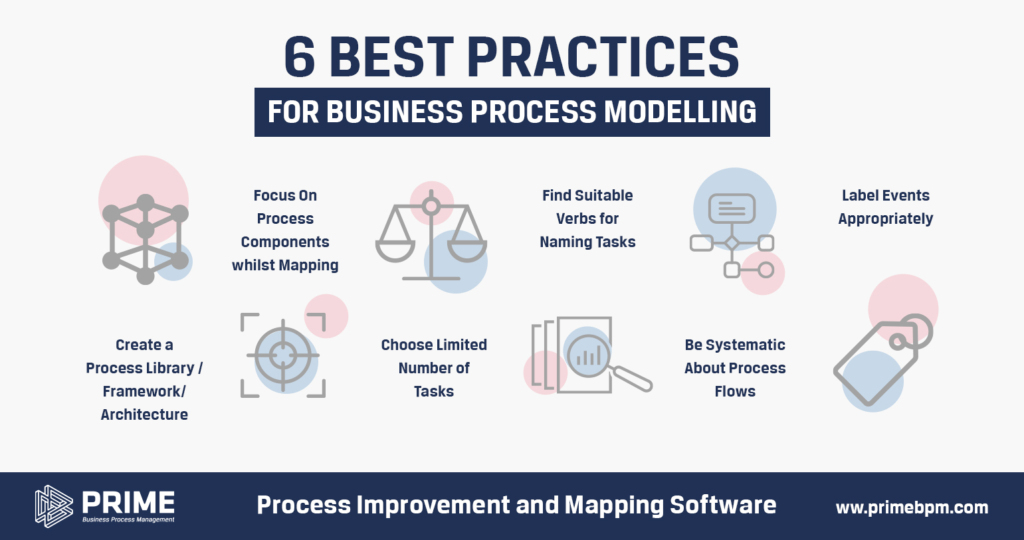Good practice in business process modelling is mandatory for managing and measuring processes. It forms the base for all activities going forward. Without a good base, redesigning the processes is almost impossible. This leaves the aim of better process performance and increased productivity as only a dream. In short, Success of your business improvement initiative is highly dependent on how well your organisation’s processes are documented, and business process modelling is a good way to do this. So, how can we ensure that business process modelling is done well?? What are the best practices in Business Process Modelling? Below are 6 simple yet reliable steps to follow.
1. Create a Process Library / Framework/ Architecture
Start your initiative by scoping your business for business processes. Ask questions which processes exist in the organisation and create a Process Library. This is the hierarchy that holds the names of all the business processes in the organisation or section of the organisation.
- As your organisation’s standard, set a minimum and maximum limit of tasks per process (i.e. 5-20 tasks)
- Count tasks by thinking at the “right” level (e.g. don’t count tasks such as “review” or click”
- Do you have two processes in one? – Separate the processes if they exceed your maximum number of tasks.
- Name your processes specifically (e.g. do not use verbs such as “manage” or “review”
Following these steps to layer down your processes results in arriving at your true process. That is, the process that you can now start to map/document in detail.
2. Focus On Process Components whilst Mapping
A business process model is so much more than a regular flowchart. At a minimum, it must contain four distinct components i.e. a) Tasks, b) Roles, c) Documents, and d) Applications for overall analysis and improvement of the process.
- Tasks: Breaking down a process into several tasks gives a detailed view of all the process activities. It offers more efficient analysis and improvement opportunities through splitting, merging and reordering of tasks.
- Roles: Mention the role names to clearly define the responsibilities of the people involved in the process. Amongst other benefits. This gives a clear overview whether a person is are over or underutilised throughout the execution of the process.
- Documents: Include the documents used throughout the execution of a process in the process map. It ensures document consistency and proper data transfer across the organization.
- Applications: Mention all utilised applications in the process map. This highlights the possibility to use the application for other tasks in the process. Future changes can also impact the use of these applications.
3. Choose Limited Number of Tasks
Your organisation is in actual fact one long, interconnected process. However, putting all of them in one process map is not at all a feasible job. Such a process does not offer good comprehension about the process. To provide ease of comprehension, break down the process into several logical manageable ‘chunks of information’. From experience backed up by best practices, the ideal length of a business process is between 5 and 20 tasks. Thus, A business process map includes a limited number of logical, manageable and comprehensible tasks. It makes the document to-the-point and easy-to-understand for the process doers.
4. Find Suitable Verbs for Naming Tasks
‘Tasks’ are the foundation of a business process. Hence, the names of tasks in a business process model must be clearly defined verbs that accurately reflect the current activity. Avoid verbs such as “manage” and “review”, as these are too high level and do not reflect precisely what is happening in the process.
5. Be Systematic About Process Flows
Follow a systematic approach, while representing process flows. A process flow guides the eye of the reader and describes the flow of the process. Hence, keep it organized by displaying not crossing any process flows so that the reader and the person who should be undertaking the task, knows which step the complete first, second etc.
6. Label Events Appropriately
Consider that an “event” happening during the course of a process affects process flow and often triggers a result. These events may show the reader where the process starts, where it ends, or where communication of a message occurs.
A good process map should have all events labelled. That is a small text description of 1-2 words describing for example what is being ‘sent’ or ‘received’. This good practice gives better clarity of what other “activities” are happening apart from the step-by-step tasks with in a process.
Set your best practices for business process modelling BEFORE you start your process mapping initiative. This ensures that all team members use the same “language” in documenting the business processes. When it is time to read the process maps and make changes to these for business improvement, the last thing you want to find is that all have been created using a “different” language. Many of which you will not be able to understand- hence hindering your business improvement progress.
PRIME BPM provides you crash courses which can help you kickstart your business process management project effectively. You can register for the crash courses:


